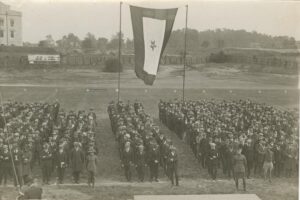The first in a five-part series highlighting Indiana University’s role in the first World War.

The entry of the United States into World War I on April 6, 1917, caused a rise in patriotism as people across the country sought to contribute to the war effort. At Indiana University, President William Lowe Bryan urged, “Your first thought every day should be in what you can most effectively serve your country.” In true Hoosier fashion, the students, faculty, and alumni rose admirably to the occasion.
By the fall semester of 1918, 60 percent of the student population had enlisted in the Student Army Training Corps, and students, professors, and alumni were sent overseas. Male students enrolled in new Military Science courses to prepare for enlistment, while female students and faculty worked in the on-campus Red Cross Workshop and on behalf of other war relief work. The Indiana Daily Student kept those living in Bloomington informed about the progress of the war, especially news of current students and alumni who had enlisted or gone abroad with the Red Cross.
IU Military Courses
In June of 1917 — two months after the U.S. declared war on Germany — Indiana University established a Department of Military Science and Tactics. The school’s first military courses were offered that fall. The goal was to prepare male students for eventual military service, so to this end, IU established a number of classes focused on topics related to the military and the current conflict overseas. Just a few examples of these classes are “Causes of the Great War,” “Balkan Problems,” “European Governments,” “Mechanics of an Airplane,” and “Military Science.”

The courses for a degree were condensed, which allowed male students to complete the academic coursework for a major in just two years. These condensed courses were offered in the areas of Astronomy, Botany, Chemistry, Economics, Sociology, Education, Geology, Mathematics, Physics, Political Science, Psychology, Romance Languages, Technicians, and Zoology.
During the summer of 1918, the Board of Trustees signed a contract with the government to use campus space to teach radio and signal work to drafted servicemen in the U.S. Army Training Detachment. But not all of the classes inspired by the war were for the male students. For the 1918-1919 academic year, emergency courses for women were created for training and instruction in first aid, surgical dressings, the making of garments for Red Cross and civilian relief, emergency social service, elementary hygiene, and home care of the sick.
[Find out more infomation about the Department of Military Science at the University Archives.]
War Service Flag

The Indiana University Service Flag was created during World War I to honor IU students, faculty, and alumni who served the United States in wartime. The flag cost $80, which, accounting for inflation, would be over $1,200 today. There are blue and gold stars on the flag. The blue stars represent the number of men enlisted in the military while the gold stars represent those who died in service to the country. There are fifty-two gold stars from the World War I era. The remainder of the stars represent those who served or died in the Civil and Spanish-American Wars, and a portion of WWII.
The flag was on display at the S.A.T.C. induction on October 1, 1918. Several years later it was displayed on campus during WWII. The flag is currently housed in the University Archives.
Leave a Reply